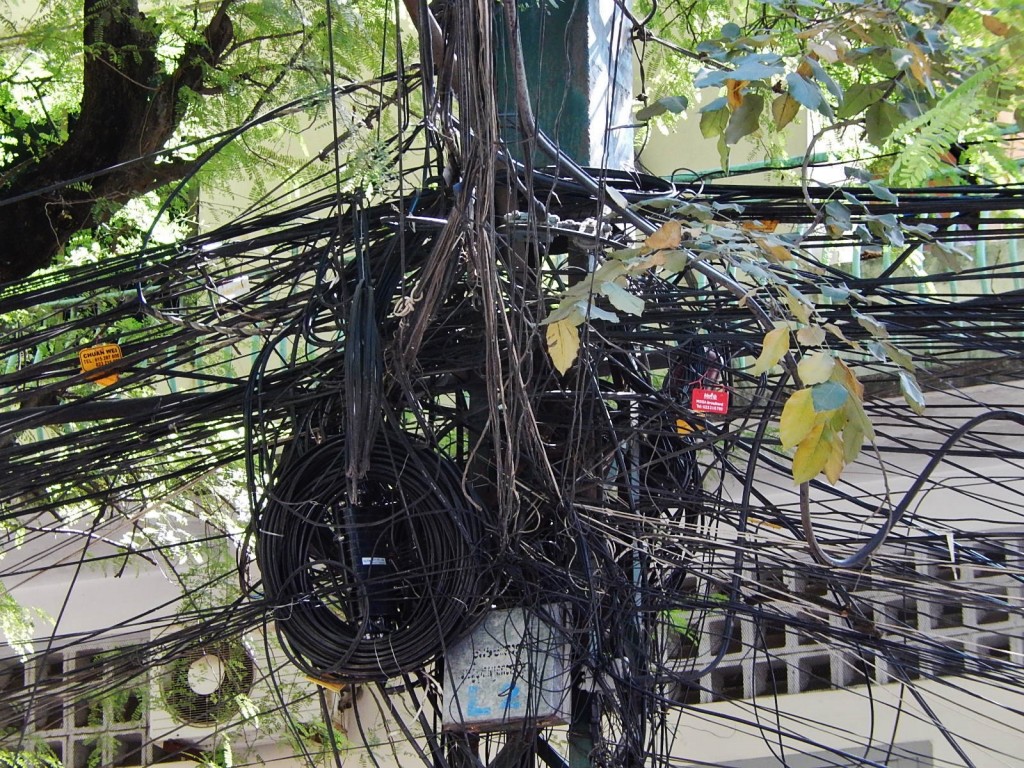In Cambodia, electricity demands have been forecast to grow at 17.9 percent annually from 2012 to 2020.1 Distribution of electricity around the country has been a challenge: according to UN data, 79 percent of people live in rural areas,2 and the entire national population had grown to 15.76 million by 2016.3

Electrical wires. Photo by Michael Coghlan, taken on 10 January 2014. Licensed under CC BY-SA 2.0.
Cambodia has made giant strides in recent years in producing more electricity domestically and expanding the grid. During the 15 years to December 2018, the capacity of power sources increased by 12.5 times, from 208 MW in 2004 to 2,650 MW in 2018.4 The energy delivered increased 11.4 times, from 814 Gwh in 2004 to 9,307 Gwh in 2018.5
A World Bank report of early 2018 found that 97.6% of Cambodian households have access to at least one source of electricity – 71.5% on the grid, and 26.1% off the grid, mostly solar home systems and rechargeable batteries.6
There are issues around reliability, however:
- 69.3% of grid-connected households face frequent unpredictable power shortages
- 32.6% of grid-connected households experience appliance damage due to voltage fluctuation
- only 13% have access to 23 hours of supply a day “with adequate reliability, quality, affordability, and health and safety”.7
Electricity supply by source
The sources of electricity generated in Cambodia have changed remarkably in recent years:
- Diesel and heavy fuel oil produced 89.2% of the electricity in 2011, but just 8.7% by 2016 and then 1.9% in 2018.
- Hydro dams produced just 5% on the electricity in 2011, but 48.5% by 2018.
- Coal produced just 4.5% of the electricity in 2011, but 34.5% by 2018.
Growing independence
Cambodia’s reliance on its neighbors for electricity supply has been declining. In 2011, for example, 64 percent of the country’s electricity was imported.8 By 2016, this had fallen to 22%, and by December 2018 to 14.5%.9 Vietnam is by far the largest supplier, followed by Thailand and then Laos.
Prospects and challenges
Energy imports are likely to continue for several years – the development of new high-voltage lines between Cambodia and neighboring countries is continuing. Investors from other countries will remain the key players in the development of the Cambodian energy sector.
Solar power is emerging as an energy source with considerable potential for Cambodia. By the start of 2019 there was already one solar plant in operation, a 10MW facility in Bavet, with a larger (60MW) plant due to begin operations by the end of 2019 on 200 hectares of land beside National Road 51 in Kampong Speu.10
In April 2019 the government approved two more.11 Schnei Tec Co., Ltd plans to build one 60 MW solar power generation plant in Pursat and another of the same capacity in Kompong Chhnang, with a total investment capital of US$116 million.12
China is the largest investor in building hydropower dams in Cambodia. According to the Ministry of Mines and Energy, Chinese companies have invested over US$1.6 billion in Cambodia’s hydropower sector.13
The Asian Development Bank (ADB) project database lists a number of projects supporting transmission, rural electrification, regional power connections, as well as general support for the power sector.14 The World Bank (WB) has committed support in the past for rural electrification and transmission.15 Cambodia has also secured bilateral funding in the power sector, and in September 2012, India agreed to provide a loan of US$70 million to fund high voltage transmission lines.16
Reducing the price of electricity is a key aim of the government. Electricity in Cambodia is regarded as among the most expensive in the region. The least expensive comes from the national grid and costs $0.11–0.27 per kilowatt hour.17 Chea Serey, director-general of the National Bank of Cambodia, has said that high electricity costs mean the country will struggle to be competitive as a manufacturing destination. She believes this will change with developments underway. “Our energy prices are right now the highest in ASEAN, but I am confident that in five to 10 years it could be the lowest in the region.”18
Last updated: 18 April 2019
Related to electricity production
- Energy policy and administration
- Renewable energy production
- Non-renewable energy production
- Hydropower dams
References
- 1. Cambodia Investment Guidebook, CDC, 2013, P. IV-2. Accessed 25 November 2014. http://www.cambodiainvestment.gov.kh/#fragment-3-tab.
- 2. World Bank, https://data.worldbank.org/indicator/SP.RUR.TOTL.ZS Accessed 24 March 2018
- 3. World Bank data https://data.worldbank.org/indicator/SP.POP.TOTL Accessed 24 March 2018
- 4. Electricity Authority of Cambodia 2018. Salient Features of Power Development in Kingdom of Cambodia until December 2018. Consolidated Report for the year 2018. https://eac.gov.kh/site/annualreport?lang=en Accessed 21 April 2019.
- 5. Ibid
- 6. World Bank 2018. Cambodia beyond connections Energy access diagnostic report, Washington DC, 15 March 2018. http://documents.worldbank.org/curated/en/141011521693254478/Cambodia-Beyond-connections-energy-access-diagnostic-report-based-on-the-multi-tier-framework Accessed 24 March 2018.
- 7. Ibid
- 8. Electricity Authority of Cambodia, 2012. Report on power sector of the kingdom of Cambodia 2012 edition. https://eac.gov.kh/site/annualreport?lang=en Accessed 24 March 2018.
- 9. Electricity Authority of Cambodia 2018 op cit.
- 10. Sok Chan 2019. Public bidding opens for 60 MW solar project. Khmer Times, 21 February 2019. https://www.khmertimeskh.com/50580004/public-bidding-opens-for-60-megawatt-solar-project/ Accessed 18 April 2019.
- 11. Cambodia Constructors Association 2019. Government approves three electricity plants. 6 April 2019. https://www.construction-property.com/read-news-1750/ Accessed 18 April 2019.
- 12. Ibid
- 13. “6th China-built hydropower dam in Cambodia starts operation”. Xinhua. Accessed 5 August 2014. http://news.xinhuanet.com/english/world/2014-08/14/c_133555997.htm.
- 14. ADB Cambodia Project Database: http://adb.org/projects/search/519
- 15. World Bank Cambodia Project Database, http://www.worldbank.org/en/country/cambodia/projects/all, accessed in September 2012.
- 16. Stuart Alan Becker & Rann Reuy, “$70m from India for Power”, The Phnom Penh Post, dated 3 September 2012;http://www.phnompenhpost.com/business/70m-india-power, accessed on 8 December 2014.
- 17. Chea Vannak, 2017. “Cabinet approves power projects”, The Khmer Times, 20 February 2017.
- 18. Kali Kotoski, 2017. Op cit.

